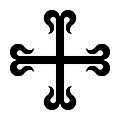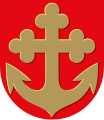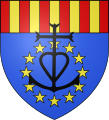
The anchored cross, or mariner's cross, is a stylized cross in the shape of an anchor. It is a symbol which is shaped like a plus sign depicted with anchor-like fluke protrusions at its base. There are many variations on this symbol, but the most common form connects a ring with a bar, with a cross-bar, terminating on the other end with two curved branches or arrowheads. The anchor symbolizes hope, steadfastness, calm and composure. It also can symbolize security in one or more uncertain experiences of life, such as sea voyages, one's fate after death, and the vagaries of fortune.
Background
The anchor cross may be referred to as the "Cross of Hope," a concept dating back to (and perhaps before) Hebrews 6:19: "Which hope we have as an anchor of the soul, both sure and steadfast, and which entereth into that within the veil."
The use of the anchor as a symbol has been attributed to Seleucus I. The symbol was then adopted by the Jews living in the Seleucid Empire on their coinage. Therefore, the anchor as a symbol would have been widespread and familiar to early Christians. Inscriptions found in the catacomb of St. Domitilla dating back to the 1st century CE use the anchor as a symbol. The anchor is thus one of the oldest symbols used in Christianity, and in this instance it is combined with the cross, representing Jesus. Clement of Alexandria is said to have approved the use of the anchor as a symbol because of its use in scripture. Hebrews 6.19 ties the anchor to the concept of "hope," and thus Christians' hope of salvation through Christ.
Missionaries of the United Methodist Church wear the anchor cross as a reminder that their work should always be "anchored in faith, hope and love".
The region of Camargue in France created their own symbol, made to represent the "Gardian Nation [fr]" of herdsmen and fishermen, and the three theological virtues of Christianity. It has the same elements as an anchored cross:
- a cross anchory with the three fleur-de-lis replaced by camargue tridents representing Christian faith;
- an anchor representing hope; along with
- the heart of The Three Marys representing charity
St. Clement's Cross
The anchored cross is also referred to as the mariner's cross or St. Clement's Cross, in reference to the way he was supposedly martyred – tied to an anchor and thrown from a boat into the Black Sea. Despite this tradition of his untimely end at sea, Clement is considered a patron saint of sailors, and many wear his cross for protection.
In heraldry
The anchored cross is a feature in coats of arms, and flags, in which context it is referred to by the heraldic terms "anchry" or "ancre." Examples of this are found in the hooked anchor that represents Vinnytsia, Ukraine; a three-leaf cross with an anchor on the coat of arms of Pyhäranta, Finland; a patriarchal cross with an anchor in the coat of arms of Barkakra Municipality, Sweden, and Wollmatingen [de], Germany; the coat of arms of León, Spain and Tallinn, Estonia; and the personal shield of Claude Feidt, the Archbishop of the Roman Catholic Archdiocese of Aix.
Gallery
- Variants of the anchored cross
-
 Admiralty Pattern anchor
Admiralty Pattern anchor
-
 Stockless anchor cross
Stockless anchor cross
-
 Anchor cross with rope
Anchor cross with rope
-
 Anchor with wheel (wheel cross)
Anchor with wheel (wheel cross)
-
Camargue cross
-
 Cross anchory
Cross anchory
-
 St. Clement's Cross
St. Clement's Cross
-
 Anchored cross necklace
Anchored cross necklace
- Anchored cross used in heraldry
-
 Hooked anchor representing Vinnytsia
Hooked anchor representing Vinnytsia
-
 Red anchor cross
Red anchor cross
-
 Cross bottony on an anchor on the coat of arms of Pyhäranta, Finland
Cross bottony on an anchor on the coat of arms of Pyhäranta, Finland
-
 Patriarch's Cross with an anchor in the coat of arms of Barkakra Municipality (Skåne County, Sweden)
Patriarch's Cross with an anchor in the coat of arms of Barkakra Municipality (Skåne County, Sweden)
-
 Anchor of the Patriarch's Cross in the coat of arms of Wollmatingen [de], Germany
Anchor of the Patriarch's Cross in the coat of arms of Wollmatingen [de], Germany
-
 The coat of arms of the Czech city of Odolena Voda
The coat of arms of the Czech city of Odolena Voda
-
 León, Spain
León, Spain
-
 Tallinn, Estonia
Tallinn, Estonia
-
 Szeliga
Szeliga
-
 Claude Feidt Retired Archbishop of Aix-en-Provence
Claude Feidt Retired Archbishop of Aix-en-Provence
-
 Anchor cross
Anchor cross
See also
- Crosses in heraldry
- Kotwica - Poland's anchor cross, used during the Second World War
References
- ^ Klöpping, Laura (2012). Customs, Habits and Symbols of the Protestant Religion. GRIN Verlag. p. 5. ISBN 978-3-656-13453-4.
- Hebrews 6:19
- Grainger, John D. (1990). Seleukos Nikator: Constructing a Hellenistic Kingdom. Routledge. p. 2. ISBN 978-0-415-04701-2.
- "What is the origin of the anchor as a Christian symbol, and why do we no longer use it?". CHRISTIAN HISTORY.
- Maurice Hassett (1913). "The Anchor (as Symbol)" . In Herbermann, Charles (ed.). Catholic Encyclopedia. New York: Robert Appleton Company.
- "What an Anchor Cross Means". The United Methodist Church. July 19, 2019.
- "Une croix du pont du Mort, sur le site du musée de la Camargue" (in French).
- "La croix Camarguaise". www.chevalcamargue.fr (in French). Retrieved July 20, 2019.
- Stracke, Richard (October 20, 2015). "Saint Clement: The Iconography". Christian Iconography.
- Pimbley, Arthur Francis (1908). Pimbley's Dictionary of Heraldry: Together with an Illustrated Supplement. p. 3.
